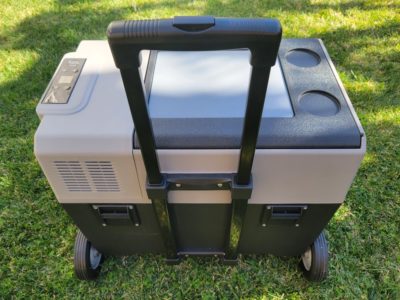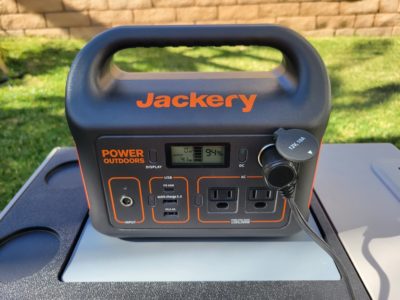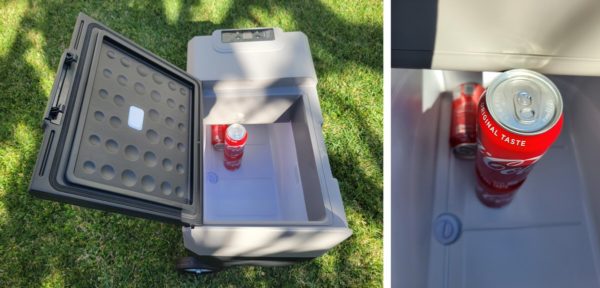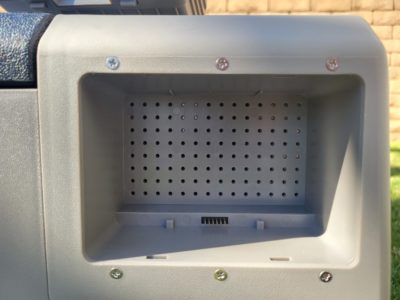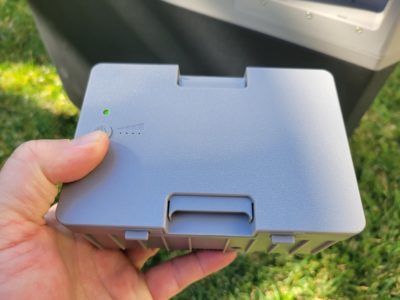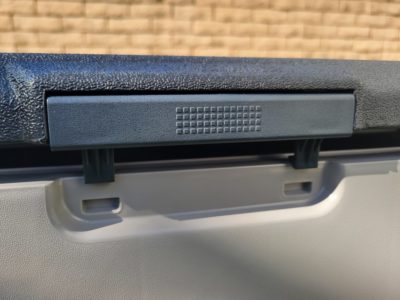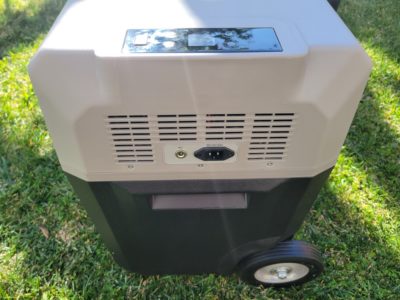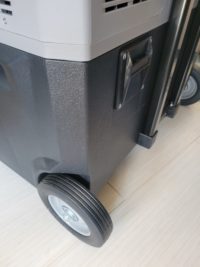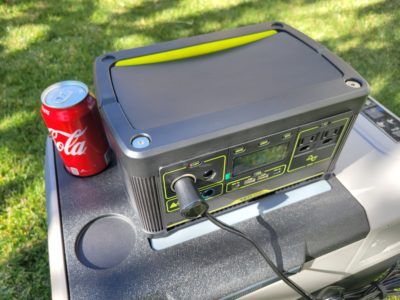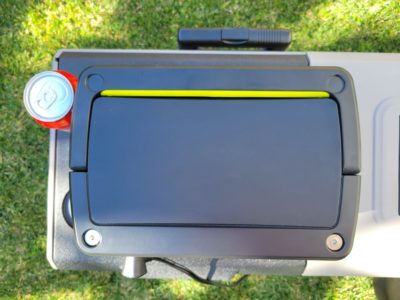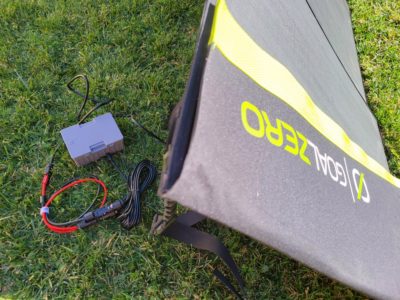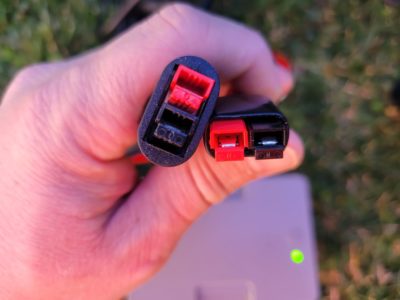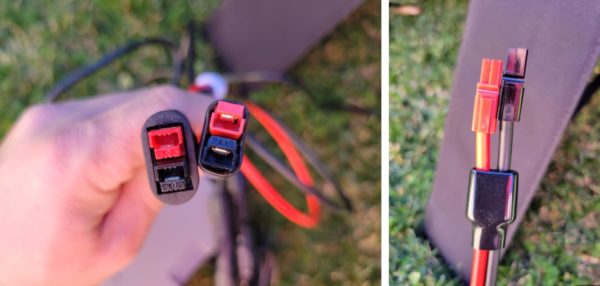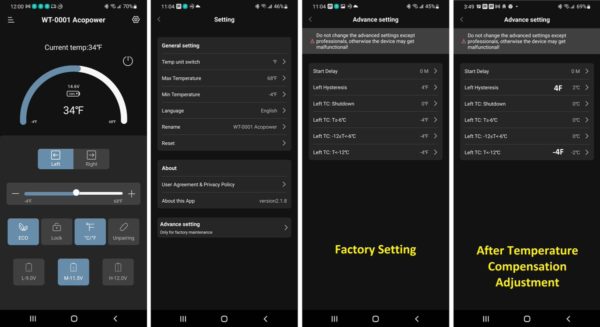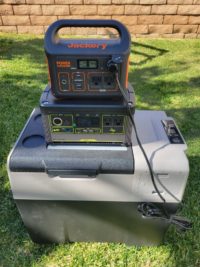
Ultimate Car Freezer?
Those who have been following my reviews may have noticed that I am an aficionado of both car freezers and battery power stations. In 2020, I had asked my favorite battery brands, Goal Zero and Jackery, to create a new product that would combine a car freezer with a battery built in, but feedback was left unanswered. Imagine my geeky surprise when an Indiegogo campaign popped up into one of my social media feeds that promised exactly what I was looking for: a self-contained car freezer that did not require hauling around a power station — the Acopower LiONCooler Pro. I was now faced with making a decision. Do I back a crowdfunding campaign for a company I never heard of and could potentially lose money on (I have been badly burnt once before)? Or do I get an older model from Amazon that would ship NOW and has the option to be returned if I did not like it?

X40A Compressor, Solar Panel, BT App /Acopower
I chose the latter option and bought the Acopower LiONCooler X40A in November 2021 to evaluate. Would this appliance deliver on all the things I wanted from a car freezer? If yes, would I want the upcoming Pro model?
Why A Car Freezer?
Car freezers have been vastly useful for road trips. Having ice-cold drinks and refreshing fruit in 110F heat at a rest stop — without having to constantly drop by a gas station to refill ice and drain melted water — had been such a blessing and time saver.

Car Freezers: Rockpals, Domende, and 2 Foho
It has been nearly two years since I purchased my first car freezer, and since then I had reviewed and compared eight of them from friends, coworkers, and family. Perhaps more interesting was that they all (including those by Smittybilt, Whynter, and Costway) were manufactured by Alpicool who also sells them under their own brand. Last year, I found the “ultimate car freezer” that had served as my favorite since: Costway 53qt/50L dual-temperature car freezer (a clone of the Alpicool T50). It allowed me to bring both refrigerated AND frozen food to camping trips at the same time. Imagine surprising the kids with ice cream when it is hot outside?
Alas, there was one inconvenience with them all: a battery power station had to be brought along, taking up precious cargo space, adding carry weight, and additional planning needed to keep said device charged. A car freezer with a built-in battery that could be charged by AC, 12V car port, or solar panel would be very convenient to have — and that is where the Acopower LiONCooler line of products come into play.
Analysis
The Acopower LiONCooler X40A is the type of car freezer I had been wanting for some time — one that has a battery built in so it could run independent of a power station. With a replaceable 173Wh battery (11.1V) and using between 25W-50W of power when cooling, it could last as short as 3.5 hours to at least 7-12 hours, depending on ambient and internal temperature, operating mode, and other factors. The colder the surrounding is and more of the content is chilled, the less the compressor has to work to keep things cool, and the longer the battery can last. Surprisingly, about 25% battery was still remaining after 16 hours of testing at 32F in 68F ambient! That was mighty efficient! In freezer mode, one should only expect about half the running time.
When cooling temperature is reached, the LiONCooler idles at around a 2W power draw. This means that it can last long enough for a party at the park and possibly also on a hot, sunny day on the beach. Of course, usage can be extended by plugging it into a power station or solar panel.
42 quarts (or 40 liters) holds a good amount of food and drink for a family of five for 3-5 days, depending on how much is consumed and what ingredients are brought. The bottom compartment is long enough to fit a whole rack of ribs, but one should take note that the temperature difference between the top and bottom was 4F-10F. This was due to the condensation coil running only along the bottom 2/3rd of the compartment. Depending on what temperature you set the appliance to, it could mean the content on the bottom could freeze and the top barely being within the safe refrigeration range. Some temperature compensation (TC) configuration may be needed (as with many car freezers) if the set temperature does not match the actual one inside the compartment. This was the case with my unit, and I had to dial the upper -6C (“E6”) and the middle -12C to -6C (“E7”) ranges from -4F down to 0F. This review will show you how to do that.
Finding the single, LG compressor at the top — a space shared with the removable, rechargeable battery — underneath the control panel was surprising. The placement keeps dirt away from the internal components, whisks any generated heat away, and is a nice design touch. However, it made me wonder if that layout prevented condensation coils from being run around the top third compartment, resulting in the top third being 4F-10F warmer than below. I did find surprising how relatively light it is (33 lbs @ 25″ L x 15.9″ W x 20″ H) compared to past fridges I had used. The compressor is rated for rough roads up to 35 degrees steep for short periods at a time and should never exceed 45 degrees while in transport.
- Front View
- Back View
- Cooling Compartment
As with all car freezers I had tested, cooling was rapid. The inside went from 72F to 32F within a VERY impressive 20 minutes and dropped to 0F half hour later. The compressor would shut off once the set temperature was reached, conserving energy and providing silence. A memory function kept the set temperature after recovering from a power loss. Reliable thermometers confirmed the temperatures within expected fluctuations.
Tip: A car freezer’s performance and energy consumption depend on the ambient temperature and how much of the content is already cold. The cooler the surrounding is, the faster the appliance can chill and the less power is used.
The standout feature of this car freezer is its connectivity options. It can be charged or powered via an AC wall outlet, 12V or 24V car port, or 12V-50V solar panel (at max 10A). Inputs cannot be combined or you may damage the appliance, and a 20′ MC4-to-5.5mm solar cable is included. The solar input is capable of accepting up to 120W @ 10A. However, only up to about 82W of input power is actually utilized: about 40W-60W goes to the compressor and 11W-22W to charge any seated battery (at up to 2A). Battery bumps to 37W charge (3A @ 12.6V) when appliance is off. The built-in battery can be charged while left in the appliance or independently with an optional AC wall brick (at 37W). In both cases, the battery must be turned ON to do so. I was told that this was per customer request. The car freezer seamlessly switched between plugged-in and battery power (if latter was on). Additional batteries are available for extra runtimes.
Caution: Charging inputs cannot be combined without potentially causing damage. Either use AC wall, 12V/24V car port, OR solar panel ONLY. Do not plug two inputs at the same time!
Tip: Battery can be charged slightly faster by having the car freezer/compressor turned off or having it charged directly off a solar panel or the optional AC wall brick.
Cleanup was simple through the addition of a drain hole. The chest-style lid firmly stayed shut, the wheels (in combination with a telescoping handle) helped move the appliance around with ease, and both side handles felt solid. At the back were some tie-downs to help secure the fridge to the car, and on top are 2 cup holders and a non-slip, glued mat. LiONCooler is rated for IP24 weather protection against water spray from any direction. (Keep it out of the rain!)
- Temperature Calibration
- AC/DC Power Input
- Jackery Explorer 300
Acopower’s control panel has a 2.1A USB port capable enough to recharge a tablet, and has a Bluetooth 4.2 app available for remote control from up to 30′ away. Unfortunately, the apps are not named the same: Android’s is called “Solar Freezer” and Apple iOS’s is “Portable Freezer”. I used neither because I was unaware of them until reading the manual recently. Instead, I had the LiONCooler connected to the Alpicool “Car Fridge Freezer” app I had already been using with previous brands, adding to my theory that this particular car freezer is made by Alpicool. Technical support said Iceco, however. Maybe Iceco’s are made by Alpicool too? Regardless, the app allows me to monitor and configure temperatures and also perform advanced programming without having to do so on the physical control panel itself.
This unit has three levels of car battery protection to prevent it from completely draining your vehicle’s battery.
Overall, as much as I like this Acopower freezer, the noise level of the LG compressor is a bit on the higher side, but perhaps should be expected considering how hard-working and efficient it is. Furthermore, the rather large temperature differential of 4F-10F between the bottom and top thirds of the compartment gives me some concern about how I would have to pack my food. Would I still recommend the LiONCooler X40A? Yes, I would. It is very unique, nearly checks every box on my “want” list, provides a better feature set for the same price as other brands I had tested, and ran a surprisingly long time on a single battery charge. This has now made me curious to see how much better the upcoming LiONCooler Pro may be.
What’s Good? What’s Bad?
Pros
- Efficient LG compressor
-
Fast cooling
- 72F to 32F after an impressive 20 mins in 72F ambient temperature
- 32F to 0F after another 30 mins
- Operating range: -4F to 68F (-20C to 20C)
- Can operate as fridge, freezer, or deep freezer
- No need to buy ice and no pool of cold water at the bottom that could affect the content
- When ON (to cool): 24W-50W used / When OFF (idle): 0W-2W
- Can be used on rough roads up to 35 degrees steep for short periods at a time
-
Fast cooling
- Built-in Li-ion battery
- Removable and rechargeable
- Only charges at about 1A-2A (11-22W) when car freezer is running, but bumps to 37W (3A @ 12.6V) when appliance is off or when directly charged via solar panel or optional AC wall brick
- 173Wh capacity (11.1V) lasted an astounding 16 hours with 25% left (32F cooling under 68F ambient temperature)
- In freezer mode, one should only expect about half the runtime
- Additional batteries are available and can be independently charged with an optional AC wall brick
- Removable and rechargeable
- Seated Battery
- Battery Compartment
- 173Wh Battery
Tip: Battery can be charged slightly faster by having the car freezer/compressor turned off or having it charged directly off a solar panel or the optional AC wall brick.
- Large compartment
- Big enough to hold 3-5 days’ worth of food for a family of 5, including a full rack of ribs package
-
Capacity: 42qt/40L – Roughly 53 soda cans
- Usable space
- Bottom 2/3rd: 18.5″ L x 10″ W x 9.3″ H (47cm L x 25.5cm W x 23.5cm H)
- Top 1/3rd: 12.6″ L x 10″ W x 5.5″ H (32cm L x 25.5cm W x 14cm H)
- Usable space
-
Exterior Dimensions: 25″ L x 15.9″ W x 20″ H / Weight: 33 lbs
- Fits a Honda Accord trunk
-
Power options
- 12V or 24V car adapter (draws 2-4A on 12V)
- 3 battery protection levels to prevent car battery from running down
- If car’s 12V port has a bypass to work directly off the battery, freezer can be used when vehicle is off. Many SUVs, trucks, minivans today have such output. See car’s owner manual
- 100-240V AC wall plug, outputting 14.5V @ 6A (or 87W)
- Auto resume: Continues operation when power is cut off and later restored
- Solar Panel with at least 100W capability or 60W output (max 12V-50V, 10A)
- With sufficient sunlight, the fridge could stay powered all day and night without needing another power source
- Input port is capable of receiving up to 120W
- Only up to about 82W of input power is actually utilized: about 40W-60W goes to the compressor and 11W-22W to charge any seated battery (at up to 2A)
- Battery bumps to 37W charge (3A @ 12.6V) when appliance is off or when recharged directly off a solar panel or the optional AC wall brick
- 12V or 24V car adapter (draws 2-4A on 12V)
Caution: Charging inputs cannot be combined without potentially causing damage. Either use AC wall, 12V/24V car port, OR solar panel ONLY. Do not plug two inputs at the same time!
- Energy modes: Max, Eco
- Tough exterior with clean lines
- Plastic wheels for easier transport that my back is very thankful for
-
Lid closes securely
- Chest style requires less vertical clearance to open
- 2 cup holders and a non-slip area included for holding small items
- Control Panel: Power, Settings, +/- temperature control
- Control Panel, USB Port
- Lid Handle
- Power Input Ports
-
Phone app: Remotely check, control, program unit via Bluetooth up to 30′ away
- “Car Fridge Freezer” by Alpicool (available for Android, Apple iOS). Acopower makes its own app, but I prefer sticking to Alpicool’s
- Convenient for adjusting or checking temps from the driver seat without having to dig through the trunk
- Built-in, internal LED light
- Drain hole for easier cleanup. Do not turn upside down to drain!
- USB charging port (2.1A)
- Advanced programming options from control panel or app. See Programming section
- Carry handles on both ends. Back can be secured to car with tie-downs
Cons
- Required a sensor adjustment
- Like many car freezers, various factors can affect temperature sensors. This can be remediated by configuring Temperature Compensation (TC) via the app or control panel. This article shows you how to do so
- Acopower’s TC settings were not manufacturer default, and as a result, cooling temperature was off by about 4F from what was desired
- After changing the TC values back to default, appliance operated within normal/expected range. I forwarded my finding to Acopower support to investigate
- Top and bottom thirds of the fridge compartment had a temperature differential of 4F-10F
- Can inadvertently freeze (bottom) content or put it (top portion) under an unsafe temperature range. Pack food, drinks, and fruit/veggies accordingly
- Built-in, removable battery can only be charged when it is turned ON
- It would have been nice to keep the battery OFF and have it always automatically charge when the freezer is turned on or connected to a power source. Technical support clarified in an emailed response that this was their original design, but customers asked to require the battery be turned ON to charge
- Only charges at about 1A-2A @ 11.1V (11.1W – 22.2W) when housed within a running car freezer. Bumps to 37W (3A @ 12.6V) when appliance is off or when recharged directly off a solar panel or the optional AC wall brick
Don’t hurt your back! Wheels and a telescoping handle are tremendously helpful with transporting the car freezer.
- Heavy, especially when full. Use the wheels!
- May be too bulky, though it fits a Honda Accord trunk
- A bit noisy when compressor is on
- AC cable end that connects to the appliance was a bit loose
- Customer service sent a replacement that fit snuggly
- Manual defrost (like most car freezers in this price range)
- Not waterproof. Keep out of rain
- No protective/insulating carry bag included
- An insulated freezer maintains its temperature better and uses less energy
Tips
- Important: Let car freezer rest for 10+ hours after delivery to allow refrigerant to settle before use or you will cut the product’s life short!
- Test the compartment with a reliable thermometer prior to use
- If temps are more than +/- 5F degrees off, you may need to re-calibrate the appliance. See Temperature Compensation
Tip: To check battery level and voltage when power is off, hold Gear (Setup) icon on the Control Panel for 3 seconds. Appliance must be plugged in to a power source or the seated battery must be turned on.
- Goal Zero Yeti 500x
- GZ Yeti 500x Top View
Compressor Power
To set: When powered on, briefly press Settings button to cycle between Max (Default), Eco.
- Max: Useful when surrounding temperature is 86F+ (30C) and Fast-Cool is needed. Runs compressor at a higher speed
- Eco: Uses less energy. Temperature fluctuates slightly. Could ruin compressor in the long run
Battery Voltage Protection
To set: When powered on, hold Settings for 3 seconds. Cycle between High (Default), Medium, Low with Settings button.
- Car freezer will turn off when battery reaches corresponding voltage level. High 11.6V / Medium 10.1V / Low 9V
- Incorrect setting could leave you stranded with a non-starting car. When connecting to:
- Battery power station. Use Medium or Low
- Car. Use High or Medium
Power On-The-Go
If you plan on taking the appliance with you on a trip, there are multiple ways to power it. Ensure the source can provide at least 60 watts. Some options:
- 12V/24V DC car outlet
- 110V AC wall charger
- Its own, removable, rechargeable 173Wh battery
- Additional batteries are available and can be independently charged with an optional AC wall brick
- Solar panel(s) connected directly to the car freezer
- Caution: Do NOT use this at the same time as charging with the car outlet or AC wall brick!
- Even though the solar port is capable of receiving up to 120W, only up to about 82W of input power is actually utilized: about 40W-60W goes to the compressor and 11W-22W to charge any seated battery (at up to 2A)
- Battery bumps to 37W charge (3A @ 12.6V) when appliance is off
- Battery power station paired with:
- 100W+ Solar panel(s)
- Car charger
- See “Runtime with Battery Power Stations” to find the right battery size for you
- Gas or propane generator
Acopower recommends charging the built-in battery with the AC wall brick to at least 30% before continuing with other methods and heading out for your trip.
Solar Panel Connection
My Goal Zero Nomad 200 solar panel has a vertically-arranged Anderson PowerPole (APP/HPP) plug. The Acopower solar cable uses the MC4 plug, and to make both products work, I had to purchase a MC4-to-Anderson adapter, such as those from iGreely.
- Battery charging with Goal Zero Solar Panel
- Goal Zero HPP (left) and iGreely APP (right)
You will notice that Goal Zero’s cable is vertically arranged whereas all other manufacturers’ Anderson cables are horizontal. It was easy to remove the rubber cover off the iGreely and then re-arrange its plug to be vertical. This now allowed the Goal Zero panel to connect to the iGreely, which in turn connected to the Acopower MC4 cable.
- Reconfigured iGreely APP cable
- Matching connectors: Goal Zero (left) and reconfigured iGreely (right)
Voila! I could now charge the Acopower’s battery with the Goal Zero solar panel.
My Traveling Setup
I plug the car freezer directly into the car 12V outlet. This charges the built-in battery at the same time (be sure to have the battery turned ON, or it won’t charge). When car is turned off, the built-in battery will continue powering the freezer. You may also plug the Acopower into a battery power station:
Car’s 12V DC outlet > Car charger > Battery power station > Battery’s 12V DC output > Car freezer
My favorites:
- Batteries: Goal Zero Yeti 1500x / Jackery Explorer 1000
- Solar Panels: Goal Zero Nomad 200 / Jackery SolarSaga 100W
- Car charger: Goal Zero Yeti Car Charger (provides a whopping 120W with a 10A outlet)
Programming
To enter programming mode: Turn unit off but keep plugged in to a power source (or turn seated Battery on). Hold “Settings” button for 3 seconds until “E1” displays. Cycle through options with “Settings”, change values with “+” or “-“. Accept setting by leaving the screen blinking until it stops a few seconds later. The various configurations can also be changed with the Bluetooth-connected app (which also is the easiest method).
PROGRAM AT YOUR OWN RISK! Improper use may void warranty and/or cause freezer to fail or be damaged.
Options
- E1 “Min Temperature”: Lowest temperature that freezer can be set to cool down to. -40C/-40F to Target temp. Default: -20C (-4F)
- Caution: setting the value too low may damage the compressor
- E2 “Max Temperature”: Highest temperature that freezer is allowed to reach. Target temp to 40C/104F. Default: 20C (68F)
- E3* “Hysteresis”: Difference from target temperature before powering up compressor again. 1C/1.8F to 10C/18F. Default: 2C (4F)
- Compressor should stop at target temperature (ie. 4C), and start again when internal temperature is E3’s value above it (ie. 4C + 2C = 6C)
- E4 “Start Delay”: Time delay protection. 0-10 mins. Default: 0 min
- To protect the compressor, it will wait that amount of time after being idle/powered off before turning on again
- E5 “Temp unit switch”: Temperature unit display. C or F. Default: F
- E6* “TC: T >= -6C”: Do not modify. Temperature compensation (for temp set to above -6C/21.2F). -10C/-18F to 10C/18F. Default: -2C (-4F)
- Displayed temperature = Detected temperature + Temperature compensation
- Used to match Displayed temperature to what is actually Detected inside the unit
- Displayed temperature = Detected temperature + Temperature compensation
- E7* “TC: -12 <= T < -6C”: Do not modify. Temperature compensation (for temp set to between -12C/10.4F and -6C/21.2F). -10C/-18F to 10C/18F. Default: -2C (-4F)
- E8* “TC: T < -12C”: Do not modify. Temperature compensation (for temp set to below -12C/10.4F). -10C/-18F to 10C/18F. Default: -2C (-4F)
- E9* “TC: Shutdown”: Do not modify. Temperature compensation “shutdown”. -10C/-18F to 0C/0F. Default: 0C (0F)
- I have no idea what this is for. Shut down the compressor when a specific, differential value is met?
* Each difference of 1C is 1.8F
Temperature Compensation (TC)
Car Freezer not cooling at the correct temperature? If you find the temperature displayed on the control panel is different than what is actually inside, the discrepancy can result in content overcooling or being too warm. For instance, if you meant to keep fruit cool at a set 40F, but the true temp inside is 32F, you will unintentionally have FROZEN fruit. Or, if you wanted to keep meats frozen at 29F, but the true temp inside is 36F, you may find the content having melted.
The displayed temperature should be roughly the same (by about 2C/4F by default, set by E3) as the actual one inside because the compressor will ONLY stop cooling when the display (not the storage’s true temp) matches the set degrees.
If you find the temperature displayed on the control panel is different than what is actually inside, the discrepancy can result in content overcooling or being too warm.
To correct the discrepancy between the set/displayed temperature and what the internal storage really is, place two, reliable thermometers inside and perform tests with temps set to 0C, -9C, and -20C (one for each of the E6-E8 TC ranges). I found the calibration easier to start with the warmer values first. If, for example, the display is 8C, 4C, and 1C higher (for each range) than what is inside, set the temperature compensations to: E6 = -8C, E7 = -4C, and E8 = -1C.
For my particular unit: The original TC values were E6 = -4F/-2C, E7 = -4F/-2C, E8 = -4F/-2C — which also is what they are after performing a Reset. After calibrating, my values were E6 = 0F/0C, E7 = 0F/0C, E8 = -4F/-2C.
Reset Settings
If you find yourself having screwed up the E1-E9 settings, you can reset them to factory defaults.
- Enter Programming Mode from the physical control panel
- You should now be at the “E1” screen
- From the control panel, hold “+” and “-” buttons together for 3 secs until “888” displays
Runtime with Battery Power Stations
- To calculate how long the car freezer could be used for (without its built-in battery) with a power station depends on its battery capacity (Wh) and how much power (W) the appliance draws
Note that this car freezer can run a LONG time with its own, built-in battery. Testing surprisingly found it operating for 16 hours at 32F in 68F ambient with 25% battery still left! That’s extremely efficient! In freezer mode, expect only about half the runtime.
- Examples are with a Jackery Explorer 1000 (1002 Wh). Halve the time when used with a Goal Zero Yeti 500x (500Wh)
- Plugged into AC port: 1002 Wh x 0.85 / Device Wattage
- About 10-15% (0.85) of power is lost during conversion from DC (battery) to AC, which is normal for all power stations
- As short as 17 hours (1002 Wh x 0.85 / 50W)
- Informal testing found an estimated use of 500-600 Wh/day as a fridge. It was idle much of the time
- Plugged into DC port: 1002 Wh / Device Wattage
- As short as 20 hours (1002 Wh / 50W)
- In reality, because the unit stays IDLE most of the time, it should last a LOT longer than the hours listed above
- Plugged into AC port: 1002 Wh x 0.85 / Device Wattage
The car freezer only uses power to reach or maintain the set temperature. Once there, it goes idle to minimize power draw. As such, the appliance could last a lot longer than the times listed above. Ambient temperature (how hot it is around the unit) greatly impacts how often and for how long the freezer’s compressor kicks in. The colder it is outside, the less power is used.
Cooling Efficiency
- The colder the set temperature and/or the warmer the ambient (surrounding) heat, the more energy will be used
- Keep in a cool location and out of direct sunlight for best efficiency
- Consider putting the appliance in an insulated bag for better cooling
- Ensure adequate air flow (4″+) on all sides of the unit, especially where the fan vents are
- The more frozen/cold items are inside, the longer they can stay cool/frozen. Avoid opening the lid too often or for too long
- An insulated, protective cover should be considered to help maintain internal temperatures better. I was unfortunately not able to find one for this Acopower
Maintenance
- Ensure lid seal is clean and unobstructed to keep cold air from escaping
- Clean inside with a damp cloth every week
- Use sodium bicarbonate (baking soda) dissolved in lukewarm water to clean anything dirty
- Allow inside to dry before closing lid and putting away
- Do not use detergent, soap, or abrasive/sharp products
- Never clean under running water
- Do NOT store the unit on its side. Always keep it upright to prevent damage to the compressor
- To defrost and remove excess ice, power off the unit and wipe dry, then power back on
- Do not allow a large amount of frost to build up on the inside of the walls as that will make cooling less efficient
Error Codes
If an error occurs, one of the following codes will display on the LCD:
- F1: Low power protection activated. Change H (High) to Medium or M to Low
- F2: Fan overloaded. Turn unit off for 30 minutes to let cool
- F3: Compressor overworked. Turn off for 30 mins to let cool
- F4: Compressor overloaded or working at low speed. Turn off for 30 mins to let cool
- F5: Compressor controller module overheated. Turn off for 30 mins and let cool in a ventilated place
- F7/F8: Temperature sensor error. Turn off and back on. Check sensor terminal(s)
Final Thoughts
When I had asked Goal Zero and Jackery in 2020 to create a car freezer with a battery built in, little did I know that Acopower already had the LiONCooler series in development. They took this a step further by making the Li-ion battery removable and solar charging capable — the outdoor geek in me was excited and salivating! I tested the car freezer for a few weeks to see if all my prayers in such an appliance were answered, but alas, even though it satisfied most items on my checklist, it fell short in a few areas. First, I had to adjust the Temperature Compensation values for the two upper temperature ranges because the factory default was off by about 4F each. This is not uncommon to do with car freezers and thankfully, the Alpicool app made it very easy to set. Second, there is a big temperature differential between the bottom 2/3rds and top third of the cooling compartment, requiring you to be mindful on how food and drinks are to be packed. Third, the battery only charges at about 1A-2A @ 11.1V (11.1W – 22.2W) when housed within the car freezer, making it slower to fill up than I would have liked. Independently (or when appliance is turned off), the battery can charge at 3A @ 12.6V (37W) directly via solar panel or optional AC wall brick.
- Front View
- LiONCooler X40A /Acopower
- Battery and Compartment
Despite the three, small shortcomings, there is no comparable car freezer on the market that offers the same or better capabilities — at least none from the major players like Goal Zero, Jackery, Ecoflow, and the like. Fast cooling car freezer? Built-in, removable battery? Solar charging capable? Wheels and telescoping handle? Very efficient compressor with surprisingly long cooling time? Check, check, check, check, and check! I am excited to see what Acopower has to offer with the upcoming LiONCooler Pro version — the company certainly has captured my attention!
Where To Buy
-
Acopower
- LiONCooler X40A 42qt/40L Car Freezer
- Spare Battery / AC Charge Controller (to separately recharge battery)
- iGreely MC4-to-Anderson solar cable adapter / Other MC4-to-Anderson cables
- Costway 53qt/50L Car Freezer (EP24413/24413-CYPE)
- Alpicool 53qt/50L Car Freezer (T50)
Related Reviews
-
Car Freezers
- Costway EP24413/24413-CYPE (53qt) Dual-temperature
- Foho BCD-52 (55qt) / BCD-32 (34qt)
- Domende HC-50 (54qt)
- Rockpals RP-25L (26qt)
References
Defrosting and How Refrigerators Work
I was fortunate (or unfortunate) to troubleshoot our home refrigerator a few years ago when it could not keep food frozen nor items cool in the fridge section, resulting in nearly a thousand dollars in lost food and medication… twice. SEARS technicians were useless and considered the unit a total loss. After having spent months researching and learning, I gained an understanding of how refrigerators work and fixed it myself. (If you are curious, 2 thermistors needed to be replaced at a couponed cost of $86.)
- A refrigerator unit consists of two compartments: freezer and refrigerator (for drinks, fruit, veggies, etc.)
- Freezer pushes cold air into the fridge section via a fan, and the warmer air from the fridge is returned to the freezer for cooling
- If the freezer fails, so will the fridge
- The compartments each have a thermistor (a resistance thermometer) to sense how cold both sections are
- Compressor (and associated fan) is turned on or off as needed to maintain the temperatures
- Over a long time, as you keep opening the door and let warmer air enter the freezer, the air moisture turns into frost/ice along the walls and shelves
- Cooling efficiency diminishes and could spoil food faster when safe temperatures cannot be maintained
- Frost build-up reduces available freezer space
- For optimal efficiency, you should defrost the freezer at least once a year by unplugging the appliance and letting the ice melt off the sides and shelves
- Have a towel ready to soak up the melted water and wipe dry the sides before turning it back on
- Today’s refrigerators have an auto-defrost cycle where heat is applied to the freezer’s evaporator coil (which is responsible for cooling)
- Melted water leaves the freezer and is evaporated by a fan
- Cycle can occur once or multiple times a day, resulting in fluctuating temperatures
- Auto-defrosting freezers cost more, use more energy, make more noise, but requires less maintenance
This car freezer (like most, if not all, in its class) does NOT have an auto-defrost cycle, and so requires occasional, manual defrosting when used for an extended period of time.





